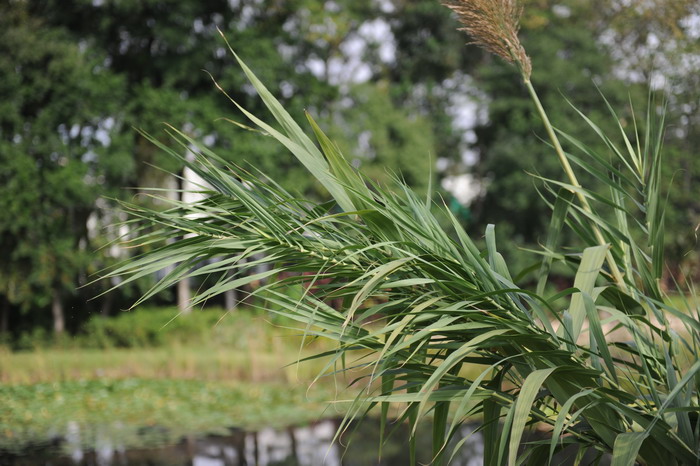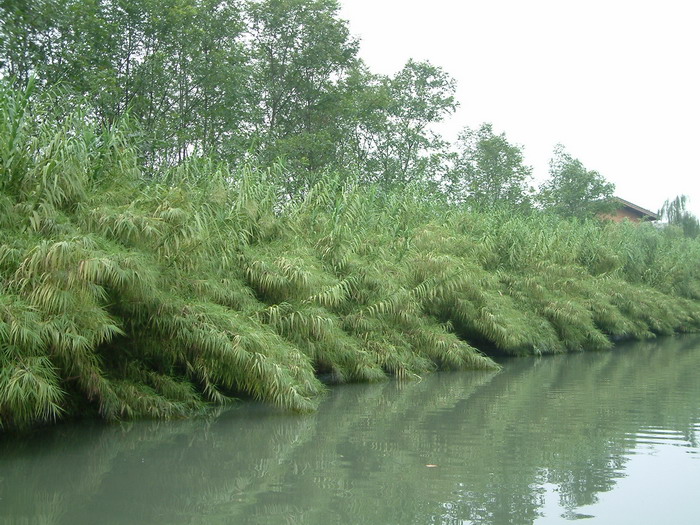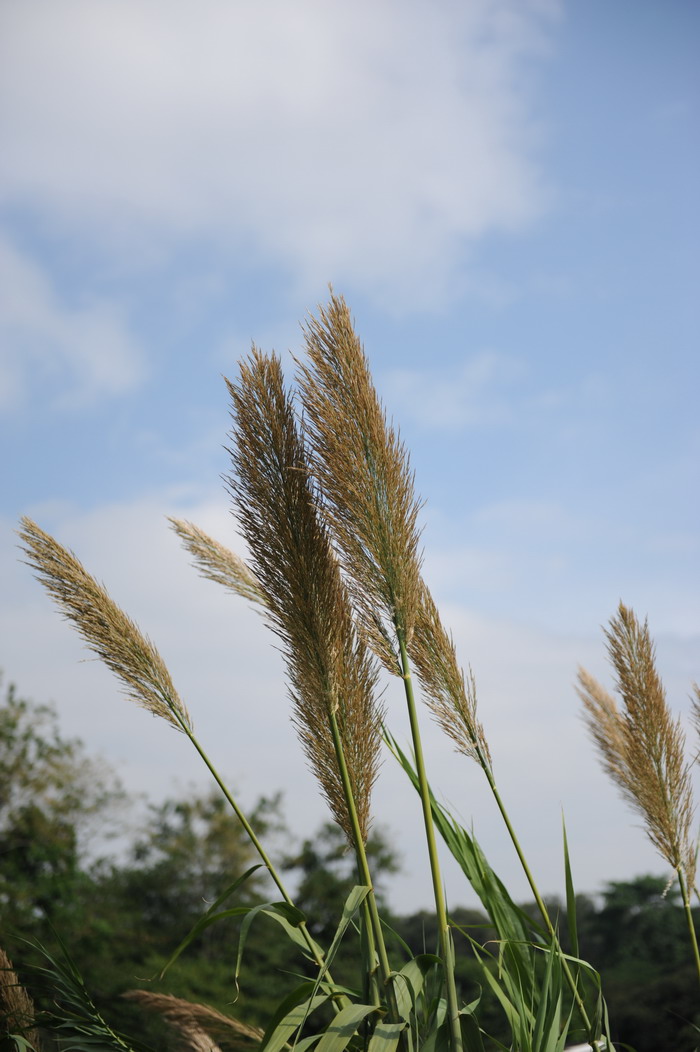芦竹 Arundo donax
中文名(Chinese Name):芦竹
学名(Scientific Name):Arundo donax L.
英文名(English Common Name):giant reed
别名(Chinese Common Name):荻芦竹
异名(Synonym):Arundo donax var. coleotricha Hack. Arundo coleotricha (Hack.) Honda Donax arundinaceus P. Beauv. Scolochloa donax (L.) Gaudin Arundo bengalensis Retz. Aira bengalensis (Retz.) Gmel. Donax bengalensis (Retzius) P. Beauv. Arundo versicolor P. Mill. Arundo coleotricha var. barbigera Honda Arundo coleotricha var. versicolor (Mill.) Stokes Donax versicolor (Mill.) P.Beauv. Arundo hellenica Danin, Raus & H.Scholz Arundo donax f. versicolor (Mill.) Beetle Arundo donax var. barbigera (Honda) Ohwi Arundo aegyptia Delile Arundo donax var. variegata E.Vilm. Arundo donax var. angustifolia Döll Arundo donax var. lanceolata Döll Arundo donax var. procerior Kunth Donax sativus C.Presl Donax sativa (Lam.) J. Presl
科属(Family & Genus):禾本科(Gramineae)芦竹属
形态特征(Description):多年生,具发达根状茎。秆粗大直立,高3-6米,直径(1-) 1.5-2.5(-3.5)厘米,坚韧,具多数节,常生分枝。叶鞘长于节间,无毛或颈部具长柔毛;叶舌截平,长约1.5毫米,先端具短纤毛;叶片扁平,长30-50厘米,宽3-5厘米,上面与边缘微粗糙,基部白色,抱茎。圆锥花序极大型,长30-60 (-90)厘米,宽3-6厘米,分枝稠密,斜升;小穗长10-12毫米;含2-4小花,小穗轴节长约1毫米;外稃中脉延伸成1-2毫米之短芒,背面中部以下密生长柔毛,毛长5-7毫米,基盘长约0.5毫米,两侧上部具短柔毛,第一外稃长约1厘米;内稃长约为外秤之半;雄蕊3,颖果细小黑色。花果期9-12月。染色体2n=12(Sahni et Bir 1985),2n=60(Larsen 1963,b),110(Hunter 1934,Pizzolongo 1962)。为5倍、6倍和9倍的非整倍体。
分布(Distribution):产华南、西南、华东及湖南、江西。生于河岸道旁、砂质壤土上。亚洲、非洲、大洋洲热带地区广布。
用途(Use):茎纤维长,长宽比值大,纤维素含量高,是制优质纸浆和人造丝的原料。幼嫩枝叶的粗蛋白质达12%,是牲畜的良好青饲料。
引自中国植物志英文版FOC Vol. 22 Page 448
Arundo donax Linnaeus, Sp. Pl. 1: 81. 1753.
芦竹 lu zhu| Poaceae | Arundo
Aira bengalensis (Retzius) J. F. Gmelin; Amphidonax bengalensis (Retzius) Nees ex Steudel (1854), not Roxburgh ex Nees (1836); Arundo bengalensis Retzius; A. coleotricha (Hackel) Honda; A. donax var. coleotricha Hackel; Donax arundinaceus P. Beauvois; D. bengalensis (Retzius) P. Beauvois; Scolochloa donax (Linnaeus) Gaudin.
Robust reed from a thick knotty rhizome. Culms very stout, erect, 2–6 m tall, 1–1.5 cm in diam., unbranched or with bamboolike clusters of slender branches from nodes. Leaf sheaths longer than internodes, usually glabrous except long pilose at mouth; leaf blades 30–60 × 2–5 cm, margins scabrous, tapering to a slender filiform apex; ligule 0.7–1.5 mm. Panicle 30–60 cm, dense, usually purplish; branches 10–25 cm, ascending. Spikelets 10–15 mm, florets 2–5; glumes narrowly lanceolate, 8–12 mm, 3–5-veined, lower glume acute, upper glume sharply acuminate; lemmas linear-lanceolate, 8–11 mm, 3–7-veined, dorsal hairs 5–6 mm, apex minutely bidentate with 1–2 mm awnlet from sinus, lateral veins also shortly extended; palea 1/2 length of lemma body. Fl. and fr. Oct–Dec.
River banks and other damp places, but it will also grow when planted in dryish habitats. Fujian, Guangdong, Guizhou, Hainan, Hunan, Jiangsu, Sichuan, Xizang, Yunnan, Zhejiang [Afghanistan, Bhutan, Cambodia, India, Indonesia, Japan, Kazakhstan, Laos, Malaysia, Myanmar, Nepal, Pakistan, Tajikistan, Thailand, Turkmenistan, Uzbekistan, Vietnam; N Africa, C and SW Asia, S Europe; widely introduced elsewhere].
Forms with variegated leaf blades are sometimes cultivated in gar-dens, e.g., var. versicolor (Miller) Stokes (Arundo versicolor Miller), with longitudinally green- and white-striped leaf blades. Arundo donax var. coleotricha refers to a wild variant with pubescent leaf sheaths.
The culms have many uses, including light construction, basket making, matting, musical pipes, and ornaments.



(责任编辑:徐晔春)
学名(Scientific Name):Arundo donax L.
英文名(English Common Name):giant reed
别名(Chinese Common Name):荻芦竹
异名(Synonym):Arundo donax var. coleotricha Hack. Arundo coleotricha (Hack.) Honda Donax arundinaceus P. Beauv. Scolochloa donax (L.) Gaudin Arundo bengalensis Retz. Aira bengalensis (Retz.) Gmel. Donax bengalensis (Retzius) P. Beauv. Arundo versicolor P. Mill. Arundo coleotricha var. barbigera Honda Arundo coleotricha var. versicolor (Mill.) Stokes Donax versicolor (Mill.) P.Beauv. Arundo hellenica Danin, Raus & H.Scholz Arundo donax f. versicolor (Mill.) Beetle Arundo donax var. barbigera (Honda) Ohwi Arundo aegyptia Delile Arundo donax var. variegata E.Vilm. Arundo donax var. angustifolia Döll Arundo donax var. lanceolata Döll Arundo donax var. procerior Kunth Donax sativus C.Presl Donax sativa (Lam.) J. Presl
科属(Family & Genus):禾本科(Gramineae)芦竹属
形态特征(Description):多年生,具发达根状茎。秆粗大直立,高3-6米,直径(1-) 1.5-2.5(-3.5)厘米,坚韧,具多数节,常生分枝。叶鞘长于节间,无毛或颈部具长柔毛;叶舌截平,长约1.5毫米,先端具短纤毛;叶片扁平,长30-50厘米,宽3-5厘米,上面与边缘微粗糙,基部白色,抱茎。圆锥花序极大型,长30-60 (-90)厘米,宽3-6厘米,分枝稠密,斜升;小穗长10-12毫米;含2-4小花,小穗轴节长约1毫米;外稃中脉延伸成1-2毫米之短芒,背面中部以下密生长柔毛,毛长5-7毫米,基盘长约0.5毫米,两侧上部具短柔毛,第一外稃长约1厘米;内稃长约为外秤之半;雄蕊3,颖果细小黑色。花果期9-12月。染色体2n=12(Sahni et Bir 1985),2n=60(Larsen 1963,b),110(Hunter 1934,Pizzolongo 1962)。为5倍、6倍和9倍的非整倍体。
分布(Distribution):产华南、西南、华东及湖南、江西。生于河岸道旁、砂质壤土上。亚洲、非洲、大洋洲热带地区广布。
用途(Use):茎纤维长,长宽比值大,纤维素含量高,是制优质纸浆和人造丝的原料。幼嫩枝叶的粗蛋白质达12%,是牲畜的良好青饲料。
引自中国植物志英文版FOC Vol. 22 Page 448
Arundo donax Linnaeus, Sp. Pl. 1: 81. 1753.
芦竹 lu zhu| Poaceae | Arundo
Aira bengalensis (Retzius) J. F. Gmelin; Amphidonax bengalensis (Retzius) Nees ex Steudel (1854), not Roxburgh ex Nees (1836); Arundo bengalensis Retzius; A. coleotricha (Hackel) Honda; A. donax var. coleotricha Hackel; Donax arundinaceus P. Beauvois; D. bengalensis (Retzius) P. Beauvois; Scolochloa donax (Linnaeus) Gaudin.
Robust reed from a thick knotty rhizome. Culms very stout, erect, 2–6 m tall, 1–1.5 cm in diam., unbranched or with bamboolike clusters of slender branches from nodes. Leaf sheaths longer than internodes, usually glabrous except long pilose at mouth; leaf blades 30–60 × 2–5 cm, margins scabrous, tapering to a slender filiform apex; ligule 0.7–1.5 mm. Panicle 30–60 cm, dense, usually purplish; branches 10–25 cm, ascending. Spikelets 10–15 mm, florets 2–5; glumes narrowly lanceolate, 8–12 mm, 3–5-veined, lower glume acute, upper glume sharply acuminate; lemmas linear-lanceolate, 8–11 mm, 3–7-veined, dorsal hairs 5–6 mm, apex minutely bidentate with 1–2 mm awnlet from sinus, lateral veins also shortly extended; palea 1/2 length of lemma body. Fl. and fr. Oct–Dec.
River banks and other damp places, but it will also grow when planted in dryish habitats. Fujian, Guangdong, Guizhou, Hainan, Hunan, Jiangsu, Sichuan, Xizang, Yunnan, Zhejiang [Afghanistan, Bhutan, Cambodia, India, Indonesia, Japan, Kazakhstan, Laos, Malaysia, Myanmar, Nepal, Pakistan, Tajikistan, Thailand, Turkmenistan, Uzbekistan, Vietnam; N Africa, C and SW Asia, S Europe; widely introduced elsewhere].
Forms with variegated leaf blades are sometimes cultivated in gar-dens, e.g., var. versicolor (Miller) Stokes (Arundo versicolor Miller), with longitudinally green- and white-striped leaf blades. Arundo donax var. coleotricha refers to a wild variant with pubescent leaf sheaths.
The culms have many uses, including light construction, basket making, matting, musical pipes, and ornaments.
(责任编辑:徐晔春)
踩一下[0]

顶一下[3]